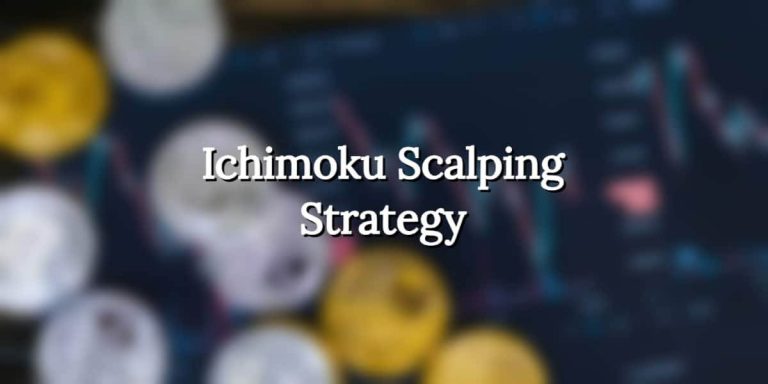Ichimoku scalping strategy – does it really works
In technical analysis-based trading, there are more or less reliable trading signals. Avoiding false signals is the primary concern of every financial markets trader be it cryptocurrencies, Forex or stocks. Here we are talking about one of the most accurate signals – the Ichimoku indicator. Also, we tackle the Ichimoku scalping strategy and its main rules. So let’s see first what the Ichimoku indicator and trading strategy represent.
Ichimoku strategy explained
Ichimoku trading strategy is a trading system based on determining the trend, support, resistance levels, and momentum. You can apply it in Forex, cryptocurrency, or the stock market. But it is most popular among Forex traders.
The Ichimoku indicator on which the strategy is based is a very accurate trading signal. Several strategies derive from this Ichimoku system. The Ichimoku scalping strategy is one of them.
The Ichimoku strategy is one of the most common strategies relying on the Ichimoku indicator. It is applied especially in Asian markets but appeared in the West markets during the 90s.
The Ichimoku method in trading is a carefully tuned charting system in which 5 lines work together to generate trading buy or sell signals. We will see how to read the Ichimoku indicator and how you can apply it in technical trading, particularly in Ichimoku scalping strategy. Let’s see first what the Ichimoku indicator is.
What is the Ichimoku indicator?
Ichimoku is a world-famous technical indicator that is based on the trend and which allows it to detect entry and exit points on any chart. This trend indicator was developed in 1930 by the Japanese journalist Hosoda Goichi. He took 30 years to perfect the Ichimoku technique and made it public in the late 1960s. It is also known as Ichimoku Sanjin.
Ichimoku uses moving averages over 3 different time frames and Ichimoku clouds to study price actions and give them a visual interpretation in order to simplify them for its users.
The Ichimoku strategy in detail – Ichimoku cloud strategy
The Ichimoku chart system, also called the Ichimoku cloud, consists of five separate lines. Four of these lines are based on separate time units:
Tenkan Sen line: an average of the lowest lows and highest highs of the last nine periods. The line represents the price balance level of the last nine periods. Tenkan Sen determines short-term movement, and we interpret it similarly to a moving average.
Standard line – Kijun Sen: an average of the lowest lows and highest highs of the last 26 periods. The line represents the price balance level of the last 26 time units. Due to its longer period, Kijun Sen is considered more of a trend measure than Tenkan Sen. A flat Kijun Sen shows a price limited to a price zone. A sloping Kijun Sen shows a trend, with the line slope showing the trend direction.
Senkou Span A (1st directional line): an average between the Tenkan Sen and the Kijun Sen, projected 26 periods forward. This average between Kijun Sen and Tenkan Sen shows a medium-term price equilibrium level, with levels of resistance/support. Projecting this line back in time makes it easier to compare prices today with prior support and resistance levels.
Senkou Span B (2nd directional line): It’s an average of the lowest lows and highest highs of the last fifty-two periods, i.e., the midpoint of the price zone over the last 52 periods, projected 26 forward periods. Senkou Span B determines the price trend over the long term.
Chikou Span (lagged line): This shows the current closing price projected 26 periods back. Although this manipulation may seem confusing at first, it gets all very clear when you consider that it allowed traders to rapidly compare the price today to the price twenty-six periods ago.
Many publications describe the different strategies that we can derive from exploiting the Ichimoku chart. The Ichimoku trading strategy overviewed in this article relies on the crosses between Kijun Sen and Tenkan Sen and the position of this cross in relation to the Ichimoku cloud.
How to scalp trading using the Ichimoku indicator
Source: freepik.com
So what are the trading rules, and how does the Ichimoku scalping strategy work? Within the following lines, you will see how Ichimoku is best used for scalping, no matter the market or time frames. It may work well for swing traders, also.
First, you should look for two filters in the Ichimoku cloud. The first filter is the moment when the price crosses over or under the price. The second one is once the conversion line crosses over or under the baseline.
If both filters take place at once, the Ichimoku will show the arrow signal. If the arrow is up, we have a buy signal which occurs when the conversion line goes over the baseline. We will have a buy signal if the arrow is down and the price of an asset goes under the Ichimoku cloud while the conversion line goes under the baseline.
The indicator will show you the exit point for your last entry trade, referring to the cross from baseline and conversion. If the cross is against the entry signal, an X will appear in the graph. The indicator only shows one signal at a time in one direction.
Entry and exit points can appear within the same candle but with different colors. The entry is usually more accurate.
What are the best Ichimoku settings for scalping?
Traders can use the Ichimoku cloud trading system for scalping and one-minute charts. But there is no one best setting. The crucial thing is to keep winners larger than losers. To put it simply, if you risk $1 in a trade, then you have to make $2 or even more on the next provisions.
Is an Ichimoku scalping strategy profitable?
To answer the question quickly, yes. And it is useful on any market and for various strategies such as swing trading, intraday trading etc.
An Ichimoku scalping strategy is profitable but on several conditions. Firstly, as an individual, you are going to have a hard time making a profit from it because of the fees applied to each position taken.
Your broker, for each order placed, will take a commission which will greatly impact your profitability.
Then, on each operation, you will try to recover a capital gain on a minimal fluctuation of the market. Therefore, you will have to spend a lot of trades per day to make your simple scalping strategy profitable.
And you would therefore be forced to use significant leverage, which will increase the capital risk.
It is for this reason that you should integrate a money management strategy directly into your simple scalping strategy.
And finally, even though some swear by scalping, in my opinion, there are much simpler and more profitable strategies, such as medium-term trend following, which will allow you to make much larger gains while spending less money. orders (I give you my method at the end of the article).
Ichimoku scalping strategy – Summary
Ichimoku strategy is a trend-following strategy that relies on 5 precise trend lines or indicators. These lines/cloud forms give the trader a detailed view of price activity, allowing them to identify better trading opportunities.
Ichimoku indicators and trading strategies can be used in all markets. However, it is important to thoroughly scrutinize the historical results of the strategy on the various assets you would like to trade before putting it into practice. This trading tool is handy for Forex, indices, commodities, stocks, etc.
Ichimoku scalping strategy Frequently Asked Questions FAQ
What is an Ichimoku indicator?
Ichimoku is a world-famous technical indicator that is based on the trend and which allows it to detect entry and exit points on any chart. This trend indicator was developed in 1930 by the Japanese journalist Hosoda Goichi.
What is the Ichimoku cloud strategy?
The Ichimoku strategy is one of the most common strategies relying on the Ichimoku indicator. It is applied especially in Asian markets but appeared in the West markets during the 90s.
The Ichimoku method in trading is a carefully tuned charting system in which 5 lines work together to generate trading buy or sell signals.
What are the best Ichimoku settings for scalping?
Traders can use the Ichimoku cloud trading system for scalping and one-minute charts. But there is no one best setting. The crucial thing is to keep winners larger than losers. For instance, if you risk $1 in a trade, then you have to make $2 or even more on the next provisions.
The post Ichimoku scalping strategy – does it really works appeared first on FinanceBrokerage.



